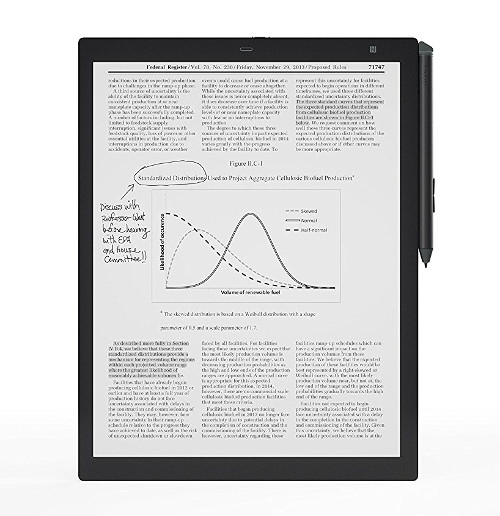One of the first in-depth reviews of the new Sony DPT-RP1 was uploaded to YouTube today.
The video is in Japanese so I can’t understand a word of it and the translation feature on YouTube is so comically inaccurate that it’s no help, but the video is very long and shows a lot of the features of the new Sony DPT-RP1 along the way.
The video is also a comparison review between the 1st gen model, the Sony DPR-S1.
The Sony DPT-RP1 is a 13.3-inch E Ink ereader that supports PDF format.
It has a new higher resolution 2200 x 1650 E Ink Carta screen that helps make the text and ink look darker and clearer (see video at 14:55).
It also sports an upgraded quad-core processor that gives it a noticeable speed boost, especially with larger PDFs (see video at 4:20).
The new model has a rechargeable stylus pen. Plus the stylus can attach to either side of the DPT-RP1 when not in use so you don’t lose it. Stylus writing looks pretty quick and accurate on the DPT-RP1 (see video at 17:20).
The Sony DPT-RP1 officially gets released in Japan on June 5th and the US on June 20th. It’s currently available to pre-order from Amazon and B&H for $699.


Does the DPT-RP1 have the ability to run the Barnes and Noble NOOK application?
No, it’s strictly a PDF reader; ebook formats and apps aren’t supported.
Surprised, it doesn’t support e-book formats, but I get it. Sony is targeting very niche markets that RE willing to pay $699 for them.
I guess the current workaround would be to convert your e-book formats into PDFs using Calibre or some other tool.
Hopefully, in a few years the price will drop to ~$250-ish, to make it a reasonable option for the consumer market.
I don’t know. To me it just seems way too big to comfortably read ebooks anyway unless you’re using a really large font size. I would think a 10-inch device would be better suited for ebooks, and the Onyx Boox N96C is currently available for around $285. It has a glass screen though so it’s actually like 130 grams heavier than the Sony despite the smaller size.
I agree with you. IMHO the main reason for a 13″ PDF e-ink reader would be PDFs that’s what I would want it primarily for.
I’m heavily in to Tabletop RPGs (Role Playing Games) — and all the game rule books and content are in PDF format (the format that make the most sense for this type of content).
The ability to read e-book formats on a 13″ e-ink reader would just be icing on the cake. An extra feature that would have some extra value.
My preferred format for e-book reading of epub and mobi books is 6″. You don’t need a big screen to read regular books, and I value the portability. I don’t have a 7″ e-reader — but that would also probably be a good size.
Ok, I watched it, a brief synopsis. We didn’t like the old model very much, thought it was too slow and just not smooth enough to use. He wasn’t expecting much improvement in the new model, and was very surprised at how all the small improvements made for a much better device. For text-based files (second pdf he showed), they’re about the same. For image scans (first file), the quad core processor makes a big difference in allowing it to cache quickly and efficiently.
The big difference was in the fit and finish. The bezel being flat with the screen makes a huge difference in making the newer version feel more like paper. Having the buttons on top is also a big plus, preventing accidental touches when writing or holding it. It’s lighter and thinner, and overall feels like holding a small stack of paper instead of a large ereader.
Before I spend twenty times as much on a display as I did for the computer, I want Linus support!
Digital Paper – $700 versus Raspberry Pi – $35
It would be a perfect low power display and portable system, BUT ‘digital assistant’ is “Windows” or maybe Mac. That was not demonstrated.
It doesn’t need an OS, or SSH or VNC, just a standard USB interface!